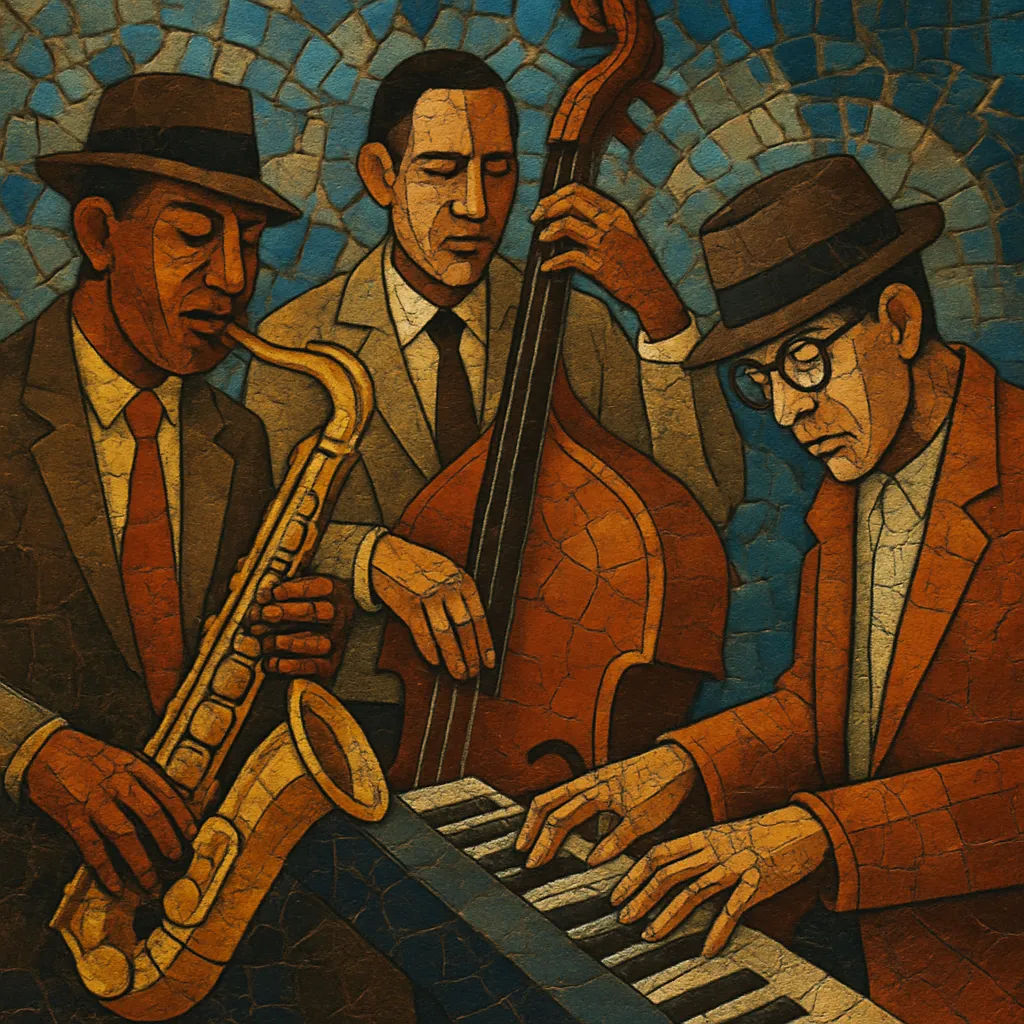Bebop is a modern jazz style characterized by fast tempos, intricate melodies, and harmonically advanced improvisation. It moved jazz from dance-oriented big-band music to art-focused small-ensemble performance, prioritizing virtuosity and spontaneous creativity.
Typical bebop groups are quintets or quartets featuring trumpet, alto or tenor saxophone, piano, double bass, and drums. The music emphasizes asymmetrical phrasing, extended chords and substitutions, and contrafacts—new melodies written over the chord changes of popular songs.
Rhythm sections center time on the ride cymbal, with the bass walking and the drummer "dropping bombs" on snare and bass drum. Melodies are angular and chromatic, and soloists outline rapidly shifting harmonies with bebop scales, enclosure tones, and altered dominants.
Bebop emerged in New York City during after-hours jam sessions at venues like Minton’s Playhouse and Monroe’s Uptown House. Musicians such as Charlie Parker, Dizzy Gillespie, Thelonious Monk, Kenny Clarke, and Bud Powell experimented with reharmonization, faster tempos, and rhythmic displacement. Their approach evolved out of the swing and big-band tradition but rejected its dance function, aiming instead for artistic autonomy and challenging, virtuosic improvisation.
Studio recordings and club performances by Parker and Gillespie in the mid-1940s solidified bebop’s language: small combos, intricate heads in unison, rapid chord cycles, and chromatic improvisation. The rhythm section’s role shifted—time on ride cymbal, walking bass, comping piano, and metric displacements from the drums—creating a buoyant, interactive texture. Composers such as Tadd Dameron contributed a sophisticated harmonic palette, while Monk’s pieces redefined bebop harmony and form.
Initially polarizing, bebop faced criticism for being too complex and non-danceable, yet it quickly became the foundation of modern jazz practice. Its contrafact method (e.g., "Anthropology" over Rhythm Changes, "Ornithology" over "How High the Moon") provided a rigorous common repertoire that honed improvisers’ harmonic fluency.
By the early 1950s, bebop’s vocabulary permeated the jazz world and catalyzed new movements: cool jazz emphasized relaxed phrasing and timbre; hard bop deepened the blues and gospel inflections; modal jazz simplified harmonic rhythm to explore scalar color; and post-bop and avant-garde jazz extended bebop’s chromatic logic into freer structures. Bebop remains a core language for jazz education and performance worldwide.
Use a small combo (quintet or quartet): trumpet and saxophone for the front line; piano, double bass, and drums in the rhythm section. Arrange heads in tight unison or harmonized lines; keep intros/outros concise and transitions clear.
Write contrafacts over common progressions (Rhythm Changes, blues, popular standards). Employ extended and altered chords (9ths, 11ths, 13ths; b9/#9/#11/b13), secondary dominants, tritone substitutions, and ii–V–I cycles in multiple keys. Practice fast modulation and voice-leading through guide tones (3rds and 7ths).
Compose angular, chromatic melodies with enclosures, approach tones, and diminished/altered scales over dominant chords. Target chord tones on strong beats and use chromatic passing tones on weak beats. Aim for asymmetrical, conversational phrasing and motivic development across the form.
Center time on the ride cymbal with a light hi-hat on 2 and 4; comp sparsely and interactively on snare and bass drum ("dropping bombs"). Maintain a walking bass that outlines chord changes clearly; pianists comp with syncopated, shell-voiced chords and rhythmic anticipation.
Favor 12-bar blues, 32-bar AABA, or other standard forms. Structure performances as head–solos–trades (4s or 8s with drums)–head out. Practice at medium tempos first, then incrementally increase speed; transcribe solos by Parker, Gillespie, and Powell to internalize bebop vocabulary.
Keep articulation crisp and lines flowing; use dynamic accents to clarify harmonic pivots. Aim for clarity of voice-leading over speed; let tone and time feel remain relaxed even at brisk tempos.


